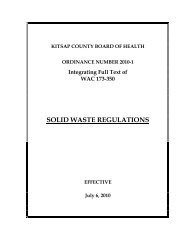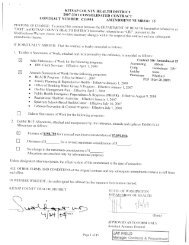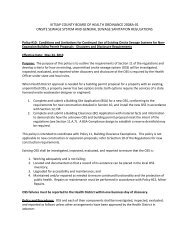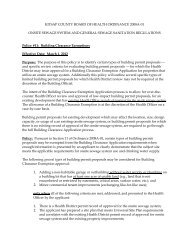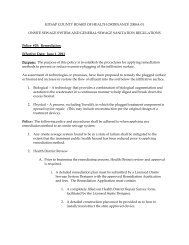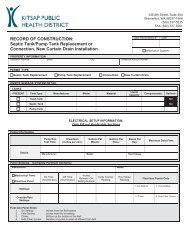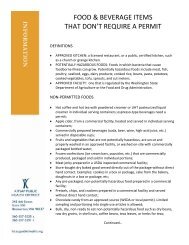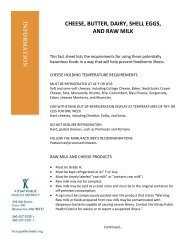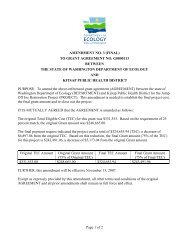Pandemic Flu - Kitsap Public Health District
Pandemic Flu - Kitsap Public Health District
Pandemic Flu - Kitsap Public Health District
You also want an ePaper? Increase the reach of your titles
YUMPU automatically turns print PDFs into web optimized ePapers that Google loves.
New<br />
Study<br />
<br />
School closures and other community strategies designed to reduce the possibility of spreading disease<br />
between people during an epidemic can save lives, particularly when the measures are used in combination<br />
and implemented soon after an outbreak begins in a community, according to a new study based<br />
on public records from the 1918-1919 influenza pandemic.<br />
The findings, which are published in the Aug. 8 issue of the Journal of the American Medical Association, provide vital clues to help public<br />
officials planning for the next influenza pandemic and highlight the importance of community strategies. These strategies are particularly<br />
important because the intervention most likely to provide the best protection against pandemic influenza -- a vaccine -- is unlikely to be<br />
available at the outset of a pandemic. Community strategies that delay or reduce the impact of a pandemic (also called non-pharmaceutical<br />
interventions) may help reduce the spread of disease until a vaccine that is well-matched to the virus is available.<br />
Scientists from the Centers for Disease Control and Prevention (CDC) and the University of Michigan Medical School′s Center for the<br />
History of Medicine completed an exhaustive review of public records such as health department reports, U.S. Census mortality data and<br />
newspaper archives.<br />
"Communities that were most successful during the 1918 pandemic quickly enacted a variety of measures,"<br />
said Dr. Martin Cetron, director of CDC′s Division of Global Migration and Quarantine and senior author of the study. "Those<br />
planning for the next pandemic need to carefully consider how to best use these strategies to protect people and decrease the potential impact<br />
of the next pandemic in their communities."<br />
These strategies— voluntary isolation and quarantine, dismissal of students from school classrooms,<br />
and social distancing in the workplace and community— form the basis for CDC’s guidelines for how<br />
American communities can empower themselves to confront the next influenza pandemic.<br />
The JAMA study evaluated public health measures such as school closures and cancellation of public events, which 43 American cities<br />
took during the 1918 pandemic. The researchers sought to determine whether the timing, duration and combination of such measures impacted<br />
the city′s death rate during the pandemic.<br />
To determine the public health measures′ effectiveness, the researchers analyzed each city′s excess death rate - the number of pneumonia<br />
and influenza deaths in excess of the amount expected for the time period.<br />
During a 24-week period in 1918-1919, more than 115,000 excess pneumonia and influenza deaths in<br />
the 43 cities were attributed to the pandemic. Cities that began interventions earlier had more success in<br />
decreasing excess deaths than those that implemented the measures later, regardless of how long the<br />
later interventions were in place or how they were executed.<br />
In a telling example, New York City’s early and sustained response, including isolation and quarantine<br />
and staggered business hours, resulted in the lowest excess death rate for any city on the East Coast during<br />
the time period reviewed. By contrast, Pittsburgh was well into its outbreak before implementing the<br />
interventions and experienced the highest excess death rate of any of the 43 cities.<br />
"In a world faced by the threat of avian influenza or other novel strains of influenza, it is critical to determine if such costly and socially<br />
harsh measures as school closures and cancellation of public gatherings might not only lower death and case rates, but also delay the spread<br />
and allow time for the development and distribution of effective vaccines and antivirals," said Dr. Howard Markel, director of the University<br />
of Michigan Medical School′s Center for the History of Medicine and lead author of the study. "We have demonstrated that<br />
these measures can have a real impact."<br />
The interventions assessed fell into three major categories: school closures, bans on public gatherings and isolation of sick people and<br />
quarantine of their healthy household contacts. The most common approach was closing schools combined with banning public gatherings.<br />
All but three of the 43 communities closed schools during the 24-week period studied.<br />
Influenza pandemics occur when a new influenza virus emerges to which most people have little or no immunity and the virus gains the<br />
ability to spread easily between people. The 1918 pandemic sickened about 20 percent of the world′s population and caused an estimated<br />
40 million deaths worldwide, about 550,000 of them in the United States.<br />
For more information about community strategies for pandemic influenza, please http://www.pandemicflu.gov/plan/community/<br />
community_mitigation.pdf. Page Located on the Web at www.cdc.gov/od/oc/media/pressrel/2007/r070807.htm<br />
CDC Pan <strong>Flu</strong> Prevention Study.pub/rw/Revised 9/21/07
Influenza <strong>Pandemic</strong> Facts<br />
What is an influenza pandemic ?<br />
Influenza viruses cause infections of the respiratory tract (breathing tubes and lungs). In some persons,<br />
complications of influenza can be severe, including pneumonia.<br />
An influenza pandemic is a global outbreak of disease from a new influenza A virus that is unlike past<br />
influenza viruses. Because people have not been infected with a similar virus in the past, most or all<br />
people will not have any natural immunity (protection) to a new pandemic virus.<br />
How is a pandemic different from regular flu season?<br />
A flu pandemic is a new influenza virus that could be a much more serious flu virus than seen in a<br />
typical flu season. Different from the typical strains of flu, humans would have no or little natural<br />
resistance to a new strain of influenza. Also, there is a vaccine for seasonal flu, which is prepared each<br />
season against new variations of the seasonal influenza. There is no vaccine available at this time for a<br />
flu pandemic, and it is expected to take at least six months after a flu pandemic appears to develop a<br />
vaccine.<br />
Why is an influenza pandemic so serious?<br />
Because most or all people would not have immunity to a new pandemic virus, large numbers of<br />
persons around the world can be infected. If the pandemic virus causes severe disease, many people<br />
may develop serious illnesses.<br />
Once a pandemic virus develops, it can spread rapidly causing outbreaks around the world. The U.S.<br />
Centers for Disease Control and Prevention (CDC) predicts that as much as 25% to 30% of the US<br />
population could be affected.<br />
Can a flu pandemic be prevented?<br />
<strong>Public</strong> <strong>Health</strong> in Region 2 (<strong>Kitsap</strong>, Jefferson and Clallam Counties) is working with federal, state, and<br />
other local government agencies to respond to an influenza pandemic and to maintain essential health<br />
care and community services if an outbreak should occur. In fact, governments all around the world are<br />
preparing for the possibility of a pandemic outbreak under the leadership of the World <strong>Health</strong><br />
Organization.<br />
It is not possible to prevent or stop a pandemic once it begins. A person infected with influenza virus<br />
can be contagious for 24 hours before the onset of symptoms, and for seven days thereafter, making it<br />
extremely easy for the virus to spread rapidly to large numbers of people.<br />
Although the federal government is stockpiling medical supplies and antiviral drugs, no country in the<br />
world has enough antiviral drugs to protect all their citizens. Anti-viral drugs can be used to treat<br />
severe cases as long as there was a reasonable chance that the drugs might help save lives. Antiviral<br />
drugs might also be prioritized for people who work in essential occupations, such as health care<br />
workers.
Other strategies for slowing the spread of a severe influenza outbreak could include temporarily closing<br />
schools, sports arenas, theaters, restaurants, taverns, and other public gathering places and facilities.<br />
There currently is no vaccine to protect humans against a pandemic influenza virus because the<br />
pandemic virus has not yet fully developed. However, vaccine development efforts are under way to<br />
protect humans against a pandemic influenza virus that might develop from the current bird flu virus<br />
in Asia. (See information on bird flu below).<br />
When is an influenza A pandemic expected?<br />
Influenza pandemics occur naturally. There were 3 pandemics in the 20th century. The pandemic of<br />
1918-19 was the most severe pandemic on record, in which 50 million or more persons around the<br />
world died, including approximately 650,000 Americans.<br />
It is not possible to predict accurately when influenza pandemics will occur or how severe they will be.<br />
However, the current outbreak of avian influenza in Asia has influenza experts concerned that a<br />
pandemic is developing that may be severe.<br />
Why does the current bird flu outbreak in Southeast Asia pose a risk of causing an<br />
influenza A pandemic outbreak in humans?<br />
New human influenza viruses arise from bird influenza viruses that then change to a form that can<br />
infect humans and spread readily from person to person. The current bird flu outbreak in Asia is caused<br />
by a type of influenza A virus called “H5N1.” The H5N1 outbreak among domestic chickens and ducks<br />
in Asia is widespread and uncontrolled. Human infections and deaths due to the avian H5N1 virus<br />
have occurred, although the virus has at this time not developed the ability to pass easily from person to<br />
person and cause outbreaks in humans.<br />
What are the symptoms of bird flu in humans?<br />
The reported symptoms of bird flu in humans have ranged from typical influenza-like symptoms (e.g.,<br />
fever, cough, sore throat, and muscle aches) to eye infections (conjunctivitis), pneumonia, acute<br />
respiratory distress, viral pneumonia, and other severe and life-threatening complications.<br />
What can the public do to reduce their risk of an influenza pandemic ?<br />
• Stay informed. These web sites provide regularly updated information about bird flu and flu<br />
pandemic:<br />
<strong>Kitsap</strong> <strong>Public</strong> <strong>Health</strong> <strong>District</strong> www.kitsappublichealth.org<br />
Clallam County <strong>Health</strong> & Human Services www.clallam.net/<strong>Health</strong>Services/<br />
Jefferson County <strong>Public</strong> <strong>Health</strong> www.jeffersoncountypublichealth.org<br />
Centers for Disease Control and Prevention (CDC) www.cdc.gov<br />
For information on the vaccine development process, visit the National Institutes of <strong>Health</strong><br />
at www.niaid.nih.gov<br />
• Stop germs from spreading.<br />
Cover your mouth and nose with tissue when coughing and sneezing<br />
Wash your hands often<br />
Wear a mask if you’re asked<br />
Stay home when you are sick<br />
Visit Cover Your Cough at www.cdc.gov/flu/protect/covercough.htm<br />
Rev3/1/2012
P r e v e n t i n g t h e S p r e a d o f I n f l u e n z a<br />
Most patients with pandemic influenza will be able to remain at home<br />
during the course of their illness and can be cared for by others who live<br />
in the household. This information is intended to help you recognize the<br />
symptoms of influenza and care for ill persons in the home, both during a<br />
typical influenza season and during an influenza pandemic.<br />
At the outset of an influenza pandemic, a vaccine for the pandemic flu virus will not be available for<br />
several months. However, it’s still a good idea to get a seasonal flu vaccine to protect from seasonal flu<br />
viruses.<br />
Because influenza can spread easily from person to person, anyone living in or visiting a home where<br />
someone has influenza can become infected. For this reason, it is important to take steps to prevent<br />
the spread of influenza to others in the home.<br />
S y m p t o m s o f I n f l u e n z a<br />
Sudden onset of illness<br />
Fever higher than 100.4º F (38º C)<br />
Chills<br />
Cough<br />
Headache<br />
Sore throat<br />
Stuffy nose<br />
Muscle aches<br />
Feeling of weakness and/or exhaustion<br />
Diarrhea, vomiting, abdominal pain (occur more<br />
commonly in children)<br />
C a r e g i v e r s — W h a t Y o u C a n D o<br />
Separate influenza patients from other people as much as possible. When practical, the ill person<br />
should stay in a separate room where others do not enter. Other people living in the home should<br />
limit contact with the ill person as much as possible.<br />
Designate one person in the household as the main caregiver for the ill person. Ideally, this<br />
caregiver should be healthy and not have medical conditions that would put him or her at risk for<br />
severe influenza disease. Medical conditions that are considered “high risk” include:<br />
Pregnancy<br />
Diabetes<br />
Heart problems<br />
Kidney disease<br />
Disease or treatment that suppresses the immune systems<br />
Chronic lung disease, including asthmas, emphysema, cystic<br />
fibrosis, chronic bronchitis, bronchiectasis and tuberculosis (TB)<br />
Over 65 years of age<br />
Watch for influenza symptoms in other household members.<br />
Contact your health care provider if you have questions about caring for the ill person. However, it<br />
may be difficult to contact your usual healthcare provider during a severe influenza pandemic. <strong>Public</strong><br />
<strong>Health</strong> in Region 2—Clallam County <strong>Health</strong> & Human Services, Jefferson County <strong>Public</strong> <strong>Health</strong> and<br />
<strong>Kitsap</strong> <strong>Public</strong> <strong>Health</strong> <strong>District</strong>—will provide frequent updates, including how to get medical advice.<br />
Special telephone hotlines will be used. These numbers will be on the websites and announced<br />
through the media.<br />
Wear surgical masks (with ties ) or procedure masks (with ear loops). Masks may be useful in<br />
decreasing spread of influenza when worn by the patient and/or caregiver during close contact<br />
(within 3 feet). To be useful masks must be worn at all times when in close contact with the patient.<br />
The wearing of gloves and gowns is not recommended for household members providing care in the<br />
home but washing hands frequently is.
I n t h e H o u s e h o l d — W h a t Y o u C a n D o<br />
Wash hands with soap and water. If soap and water are not available, use an alcohol-based hand<br />
cleanser after each contact with an influenza patient or with objects in the area where the patient is<br />
located. Thorough hand cleaning by everyone in the household is the single best preventative<br />
measure against the spread of the flu.<br />
Don’t touch your eyes, nose or mouth without first washing your hands for 20 seconds. Wash<br />
hands before and after using the bathroom<br />
Wash soiled dishes and eating utensils either in a dishwasher or by hand with warm water and<br />
soap. It’s not necessary to separate eating utensils used by a patient with influenza.<br />
Laundry can be washed in a standard washing machine with warm or cold water and detergent. It is<br />
not necessary to separate soiled linen and laundry used by a patient with influenza from other<br />
household laundry. Do not grasp the laundry close to your body or face, in order to avoid<br />
contamination. Wash hands with soap and water after handling soiled laundry.<br />
Place tissues used by the ill patient in a bag and throw them away with other household waste.<br />
Consider placing a bag at the bedside for this purpose.<br />
Clean counters, surfaces and other areas in the home regularly using everyday cleaning products.<br />
I n t h e C o m m u n i t y — W h a t Y o u C a n D o<br />
Stay at home if you are sick. Ill persons should not leave the home until they have recovered<br />
because they can spread the infection to others. In a typical influenza season, person with influenza<br />
should avoid contact with others for about 5 days after onset of the illness. During an influenza<br />
pandemic, public health authorities will provide information on how long persons with influenza<br />
should remain at home.<br />
If the ill person must leave home (such as for medical care), he or she should wear a surgical<br />
or procedure mask and should be sure to take the following steps:<br />
Cover the mouth and nose when coughing and sneezing, using tissues or the crook of the<br />
elbow instead of the hands.<br />
Use tissues to contain mucous and watery discharge from the mouth and nose.<br />
Dispose of tissues in the nearest waste bin after use or carry a small plastic bag (like a ziplock<br />
bag ) for used tissues.<br />
Wash hands with soap and water or use an alcohol-based hand cleanser after covering your<br />
mouth for a cough or sneeze after wiping or blowing your nose and after handling<br />
contaminated objects and materials, including tissues.<br />
During an influenza pandemic only people who are essential for patient care or support should<br />
enter a home where someone is ill with pandemic influenza unless they have already had influenza.<br />
If other persons must enter the home, they should avoid close contact with the patient and<br />
use the infection control precautions recommended on this sheet.<br />
More Information<br />
This guidance is based on current information from the U.S. Department of <strong>Health</strong> & Human services<br />
<strong>Pandemic</strong> Influenza Plan and is subject to change. Up-to-date guidance will be available from your healthcare<br />
provider and at these websites:<br />
Clallam County <strong>Health</strong> & Human Services www.clallam.net/<strong>Health</strong>Services/<br />
Jefferson County <strong>Public</strong> <strong>Health</strong> www.jeffersoncountypublichealth.org<br />
<strong>Kitsap</strong> <strong>Public</strong> <strong>Health</strong> <strong>District</strong> www.kitsappublichealth.org<br />
Washington State Department of <strong>Health</strong> www.doh.wa.gov<br />
Centers for Disease Control and Prevention www.cdc.gov<br />
Region 2 <strong>Public</strong> <strong>Health</strong>, <strong>Kitsap</strong>, Clallam and Jefferson Counties<br />
<strong>Kitsap</strong> <strong>Public</strong> <strong>Health</strong> <strong>District</strong>, 345 Sixth St., Suite 300, Bremerton, WA 98337, (360) 337-5235 3/5/2012
C a r i n g f o r S o m e o n e w i t h I n f l u e n z a<br />
During a severe influenza outbreak or pandemic, the residents of Region<br />
2—<strong>Kitsap</strong>, Clallam & Jefferson Counties - will be informed by the media<br />
and healthcare providers about how to obtain medical advice and receive<br />
medical care.<br />
The following information is a general guide and is not intended to take<br />
M o n i t o r i n g<br />
& C o m f o r t i n g<br />
Keep a care log. Write down the following information about the ill person at least once each<br />
day— or more often as symptoms change—along with the date and time.<br />
Check the patient’s temperature.<br />
Check the patient’s skin for color (pink, pale or how much the patient drinks each day and<br />
through the night<br />
Write down how many times the ill person urinates each day and the color of the urine<br />
(clear to light yellow, dark yellow, brown, or red)<br />
Write down all medications, dosages and times given.<br />
Keep the ill person as comfortable as possible. Rest is important.<br />
Tissues and a trash bag should be within reach of the patient.<br />
Fever is a sign that the body is fighting the infection. It will go away as the patient is getting better.<br />
Sponging with lukewarm (wrist-temperature) water may lower the patient’s temperature but only<br />
during the period of sponging. Do not sponge with alcohol.<br />
Watch for complications of influenza. Complications are more common in individuals with<br />
health conditions such as diabetes, heart and lung problems, but may occur with anyone who has the<br />
flu. Call your healthcare provider if the ill person:<br />
Has difficulty breathing, is breathing fast, or has a bluish color to the skin or lips<br />
Begins coughing up blood<br />
Shows signs of dehydration and cannot take enough fluids<br />
Does not respond or communicate appropriately or appears confused<br />
Complains of pain or pressure in the chest<br />
Has convulsions (seizures)<br />
Is getting worse again after appearing to improve<br />
Is an infant younger than 2 months old with fever, poor feeding, urinating less than 3 times<br />
per day or other signs of illness<br />
M e d i c a t i o n s<br />
Use ibuprofen or acetaminophen or other measures, as recommended by your healthcare provider,<br />
for fever, sore throat and general discomfort.<br />
Do not use aspirin in children or teenagers with influenza because it can cause Reye’s syndrome,<br />
a life-threatening illness.
F l u i d s & N u t r i t i o n<br />
If Not Vomiting offer small amounts of fluid often to prevent dehydration, even if he or she does<br />
not feel thirsty. If the ill person is not eating solid foods, include fluids that contain sugars and salts,<br />
such as broth or soups, sports drinks (diluted half and half with water), Pedialyte® or Lytren®,<br />
ginger ale and other sodas, but not diet drinks or drinks with caffeine. Regular urination is a sign of<br />
good hydration.<br />
Recommended minimum daily fluid intake, if not eating solid food:<br />
Young children—1 ½ ounces per pound of body weight per day<br />
(Example: A 20 pound child needs approximately 30 ounces fluid per day)<br />
Older children and adults—1 ½ to 2½ quarts per day<br />
If Vomiting do not give any fluid or food by mouth for at least 1 hour. Let the stomach rest. Next,<br />
offer a clear fluid, like water, in very small amounts. Start with 1 teaspoon to 1 tablespoon of clear<br />
fluid every 10 minutes. If the patient vomits, let the stomach rest again for an hour. Again, try to give<br />
small frequent amounts of clear fluid. When there is no vomiting, gradually increase the amount of<br />
fluid offered and use fluids that contain sugars and salts. After 6-8 hours of a liquid diet without<br />
vomiting, add solid food that is easy to digest, such as saltine crackers, soup, mashed potatoes or rice.<br />
Gradually return to a regular diet.<br />
Babies. Breastfed babies who are vomiting can continue to nurse. Feed smaller amounts more often<br />
by breastfeeding on only one breast for 4-5 minutes every 30-60 minutes or by offering teaspoonfuls of<br />
Pedialyte® or Lytren® every 10 minutes.<br />
Alcohol and Tobacco. No alcohol or tobacco use by the patient. Smoking should not be allowed<br />
in the home.<br />
Dehydration. Watch for signs of dehydration which can include:<br />
? Weakness or unresponsiveness<br />
? Decreased saliva/dry mouth and tongue<br />
? Skin tenting: check this by picking up layers of skin between your thumb and forefinger<br />
and gently pinching for 1 second. Normally, the skin will flatten out into its usual shape<br />
right away. If patient is dehydrated, the skin will “tent” or take 2 or more seconds to flatten<br />
out. This is best checked on the belly skin of a child and on the upper chest of an adult.<br />
? Decreased output of urine which becomes dark in color. Ill persons who are getting<br />
enough fluids should urinate at least every 3-12 hours.<br />
If the ill person is dehydrated, give sips or spoonfuls of fluids frequently over a 4-hour period. Watch<br />
for an increase in urination, a lighter color of the urine and improvement in the patient’s overall<br />
condition. These are signs that the increased fluids are working.<br />
O t h e r R e s o u r c e s<br />
Clallam County <strong>Health</strong> & Human Services www.clallam.net/<strong>Health</strong>Services/<br />
Jefferson County <strong>Public</strong> <strong>Health</strong> www.jeffersoncountypublichealth.org<br />
<strong>Kitsap</strong> <strong>Public</strong> <strong>Health</strong> <strong>District</strong> www.kitsappublichealth.org<br />
Washington State Department of <strong>Health</strong> www.doh.wa.gov<br />
Centers for Disease Control and Prevention www.cdc.gov<br />
Region 2 <strong>Public</strong> <strong>Health</strong>, <strong>Kitsap</strong>, Clallam and Jefferson Counties<br />
<strong>Kitsap</strong> <strong>Public</strong> <strong>Health</strong> <strong>District</strong>, 345 Sixth St., Suite 300, Bremerton, WA 98337, (360) 337-5235 5-10-11(6/04/07)
Returning to Work—Guidance for Employers<br />
When should workers who have been ill with influenza return to the<br />
workplace? This document provides an overview of influenza symptoms,<br />
criteria for employee return, and important qualifications for use of this<br />
information during a pandemic flu.<br />
I n f l u e n z a V i r u s<br />
How it spreads—Influenza viruses are spread from person to person primarily through respiratory droplet<br />
transmission (e.g., when an infected person coughs or sneezes in close proximity, normally 3 feet or less, to<br />
an uninfected person). The virus may also be spread through contact with infectious respiratory secretions<br />
on the hands of an infected person or by touching objects or surfaces contaminated with the virus.<br />
Incubation & Infection—The typical incubation period for influenza is 1—4 days, with an average of 2 days.<br />
Adults can be infectious from the day before symptoms begin through approximately 5-7 days after illness<br />
onset. Children can be infectious for 10 days after the onset of symptoms. Severely immunocompromised<br />
persons can be infectious for weeks or months.<br />
C u r r e n t C r i t e r i a f o r R e t u r n i n g t o W o r k<br />
Workers who have become ill with influenza should stay home for at least 24 hours after their fever<br />
(100° Fahrenheit or 37.8° Celsius or greater ) is gone without the use of fever-reducing medicine and<br />
regardless of whether or not antiviral medications are used.<br />
This guidance does not apply to health care settings where the exclusion period continues to be for 7<br />
days from symptom onset or until 24 hours after the resolution of symptoms, whichever is longer.<br />
GUIDANCE IS CONSTANTLY CHANGING. Check for updates at www.cdc.gov/h1n1flu/<br />
Upon returning to the work environment, employees should continue to follow cough etiquette and hand<br />
washing protocols.<br />
C r i t e r i a f o r P a n d e m i c I n f l u e n z a<br />
Experts do not know whether the mode of transmission, incubation period, or contagious period of<br />
pandemic strains of the influenza virus will remain similar to those of seasonal influenza (recurring yearly).<br />
Because of this, employers must be vigilant for specific recommendations from <strong>Public</strong> <strong>Health</strong> during an<br />
influenza pandemic regarding management of illness in the workplace, including when it is safe for<br />
workers to return to the work environment after illness with influenza.<br />
M o r e I n f o r m a t i o n<br />
<strong>Kitsap</strong> <strong>Public</strong> <strong>Health</strong> <strong>District</strong> www.kitsappublichealth.org<br />
Jefferson County <strong>Public</strong> <strong>Health</strong> www.jeffersoncountypublichealth.org<br />
Clallam County <strong>Health</strong> & Human Services www.clallam.net/<strong>Health</strong>Services/<br />
Washington State Department of <strong>Health</strong> www.doh.wa.gov<br />
Centers for Disease Control and Prevention www.cdc.gov<br />
<strong>Public</strong> <strong>Health</strong> working to prevent the spread of disease<br />
Region 2 Clallam, Jefferson & <strong>Kitsap</strong> Counties<br />
Rev 3/01/2012 (KCHD 08/14/09)



